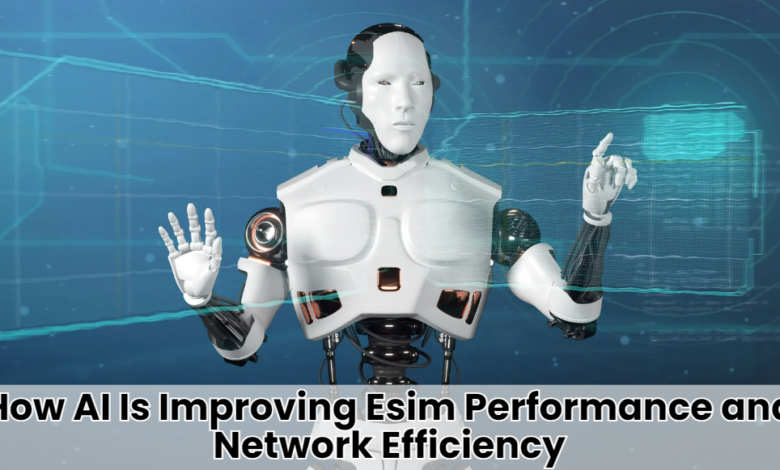How AI Is Improving Esim Performance and Network Efficiency

How can artificial intelligence advance eSIM technology? ESIM, taking the telecommunication industry to an even higher level of digitization, goes for even more flexibility than regular SIM cards.
As a result, everyone from mobile users to controlling IoT devices, to a vast network of interconnected gizmos, gets to change their providers as easily as doing a software update on your eSIM. Still, more smart devices and the requirement for uninterrupted connection put great pressure on the networks.
It is important here for AI to improve eSIM performance and network quality, interpret big data, identify possible problems, and manage networks in real time. In this blog, we will expand on how AI will define the future of eSIM technology as the latter is central to contemporary mobile networks and IoT settings.
Understanding eSIM Technology
eSIM, an abbreviation for embedded SIM, is an innovative solution to unseat the traditional SIM card. Compared to the physical SIM card that has to be inserted into a device physically, It is physically bonded to the motherboard of a device. It enables the user to switch on a mobile network or change the carrier through an update on the software rather than replacing cards.
From this, there are crucial implications that relate to the telecommunications industry. With eSIM, users can:
- Make calls, send messages, and browse the internet without a new SIM card from a new carrier.
- Activate devices remotely.
- Allow multiple network profiles on one device.
- Necessitate possible connectivity of sizeable devices such as wearables and IoT gizmos, trinkets, and gadgets.
AI’s Effect on the Network
AI has also been seen to have a massive influence on eSIM performance, as well as the general efficiency of the networks. Since AI can index data, forecast needs, and adapt instantly, it enables networks to operate more efficiently. This adaptability enhances the overall functionality of an e sim card and allows networks to grow quickly in response to the continually increasing need for connectivity.
1. Self Organizing Networks (SON)
SON can be said to define the future of telecommunications, and the same prognoses can be made for AI. It means that with the help of artificial intelligence algorithms, smart SONs can perform dynamic analysis of the network performance and undertake necessary optimizations independently.
These include signal boosting, changing routes, and distribution of loads on the networks that all devices should stay connected and running.
In an efficient and realistic AI-powered SON, the network is always in a learning mode concerning the surrounding environment. This makes it possible to scale and respond to new variables like the number of gadgets connected or a change in the viscosity of the network traffic.
Slowly the services over the network improve and the devices, which are eSIM enabled, start receiving better quality services.
2. 5G Networks and Beyond
As telecom companies start delivering 5G, the use of AI in operating networks will be even more crucial as 5G offers increased speed, less latency, and the ability to connect far more devices than 4G. To fulfill the above promises, enhancement of network management and optimization is needed which is well offered by AI.
AI will be critical in managing the orders of 5G complexity, especially in packaging large data from eSIM-enabled IoT devices. When such aspects are employed in the network, users are guaranteed to enjoy uninterrupted high-speed connection irrespective of the number of devices in any given network.
Further, future network technologies more than 5G will also require AI. When moving towards 6G and other next-gen system layouts, controlling and allocating available network resources effectively in real time will be critical. These next-generation intelligent networks will factor in AI’s versatility to analyze and execute actions in dispersed data in real time.
AI Integrated Innovation in IoT and Smart Devices
ESIM is quickly becoming a preferred solution enabling AI to transform the IoT and smart devices industry. With the increased popularity of interconnected devices and systems, a constant demand for appropriate, reliable, and secure connections between such devices and the corresponding networks arises.
Thus, AI is assisting a paradigm shift to smart connected devices that can share information and tangible or intangible conditions and respond corresponding to changes in real time. For instance, eSIM-enabled smart home devices can apply AI to understand the user’s habits as well as adapt the operation of devices according to the discovered traits.
Likewise, industrial IoT devices via AI can decide on performance and the requisite time for maintenance, which helps control the equipment’s downtimes as well as enhance efficiency.
It is also playing a vital part in the development of machine-to-machine (M2M) communication. Through the improvement of how these devices and the network interact, AI guarantees that eSIM devices can run properly from different settings without causing security concerns.
Challenges and the Future of AI in eSIM Technology
Even though it has been observed that AI is playing a massive role in eSIM performance and network effectiveness, some issues need to be addressed. However, one of the issues is how to design AI algorithms that will be scalable with the increasing number of connected devices.
There are also some issues related to security and privacy with the implementation of AI for eSIM devices. Although AI contributes to the improvement of security, it opens new opportunities for hackers. Providers of services proposing utilization of AI ought to be careful that the proposed Artificial intelligence system is well designed to withstand hackers.
Nonetheless, this is the future of AI in eSIM technology, promising times are ahead. While AI has not yet become an indispensable element of eSIM operation, developments in this field will cause AI technologies to assume a greater significant function in the administration and performance of eSIM devices and the networks they use.
AI’s Role in Optimizing eSIM Performance
| Main Idea | AI’s Role | Impact on eSIM Performance |
| Real-time Data Analytics & Predictive Maintenance | Analyzes signal strength, bandwidth, and latency in real-time | Prevents connectivity issues, reroutes traffic for smooth performance, and enhances overall network reliability. |
| AI-enhanced Security & Authentication | Detects anomalies in network traffic and automates authentication | Strengthens security by preventing cyberattacks, and ensures faster and more secure eSIM authentication. |
| Network Load Balancing & Traffic Optimization | Redistributes traffic dynamically based on real-time needs | Reduces congestion, minimizes disruptions, and ensures stable connections, even during peak network usage. |
| Network Planning & Resource Allocation | Predicts resource demand using data trends | Optimizes 4G/5G transitions, improves coverage, and ensures the availability of network resources in high-demand areas. |
| Power Optimization for eSIM Devices | Adjusts signal strength, reduces network pings | Lowers energy consumption in battery-powered IoT devices, extending device life while maintaining connection quality. |
Conclusion
AI is changing the way eSIMs work and networks need to be managed. Technologies like predictive maintenance that focus on security, meshing network loads, and power optimization are being boosted by AI to quickly examine such real-time data and make decisions on it for efficient eSIM-enabled gadgets.
FAQs
- What is an eSIM?
eSIM (embedded SIM) is a digital SIM that allows users to switch carriers without replacing a physical SIM card.
- What is the future outlook for AI and eSIM technology?
AI is expected to become integral to eSIM operations, enhancing network management and performance.
- How does AI facilitate machine-to-machine (M2M) communication in eSIM devices?
AI improves M2M communication in eSIM devices by automatically selecting the best network, ensuring secure data transfers, and allowing devices to communicate without human help. It also helps predict issues, reducing downtime and making the process faster and more efficient.



